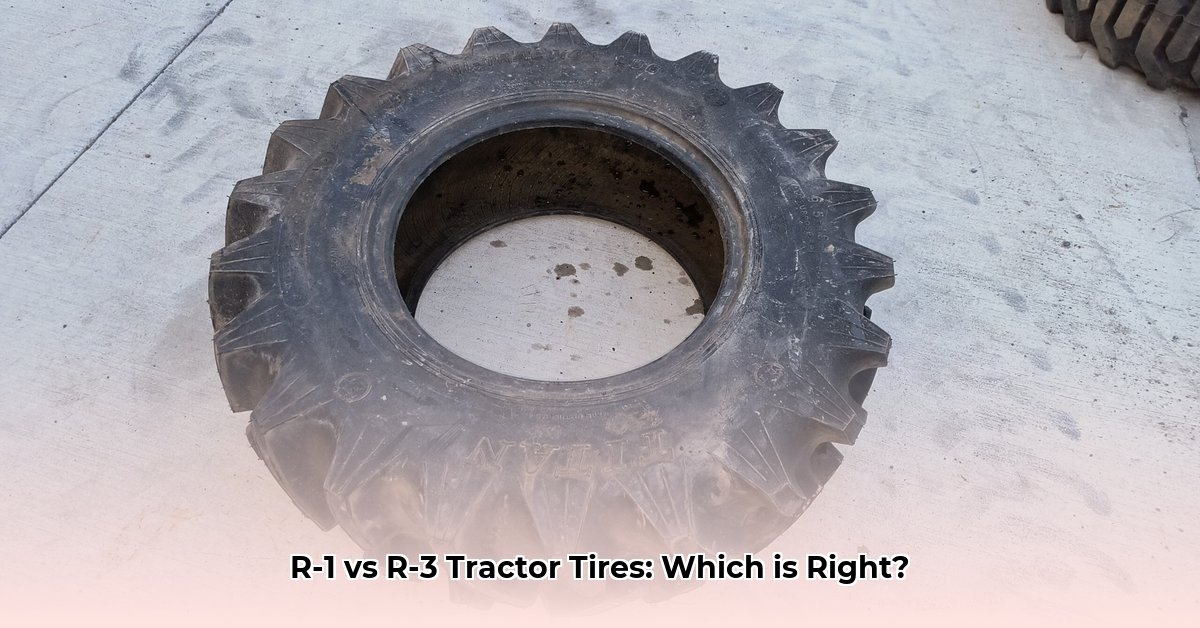
Selecting the correct 9.5-16 tractor tire is crucial for optimal farm efficiency and soil health. This guide simplifies the process, helping you decide between R-1 and R-3 tires based on your specific needs. The right tire choice translates to smoother operations, reduced soil compaction, and ultimately, a healthier bottom line. For more information on tractor tire sizes, check out this helpful guide: Tractor Tire Sizes Explained.
Understanding R-1 and R-3 Tractor Tires
The core decision lies between R-1 and R-3 tires, each designed for specific applications. Think of it like choosing the right footwear – hiking boots for rugged terrain, sneakers for a smooth track.
R-1 Tires: Maximum Traction
R-1 tires feature a deep, aggressive tread pattern designed for superior traction in challenging conditions. Imagine cleats on a football player's shoes – they dig in and grip the soil firmly. This makes them ideal for plowing, planting, and fieldwork in heavy, wet soils. However, their aggressive grip can lead to increased soil compaction. The robust design and superior grip of R-1 tires are also well-suited for heavy-duty applications which regularly involve significant resistance, such as pulling heavy loads.
R-3 Tires: Reduced Soil Compaction
R-3 tires possess a shallower, smoother tread pattern, focusing on minimizing soil disturbance. Like soft-soled shoes, they're gentler on the land. This makes them excellent for mowing, hay baling, and other operations where preserving soil health is paramount. The reduced compaction promotes healthier turf and reduces long-term soil damage. However, they might provide less traction in very wet or muddy conditions.
| Tire Type | Tread Pattern | Ideal Applications | Advantages | Potential Drawbacks |
|---|---|---|---|---|
| R-1 | Deep, aggressive lugs | Plowing, planting, heavy fieldwork in tough soils | Superior traction in challenging conditions | Increased soil compaction, potentially rougher ride |
| R-3 | Shallow, smooth lugs | Mowing, hay baling, lighter fieldwork | Reduced soil compaction, gentler on the land | Less traction in muddy or very wet conditions |
Factors Influencing Tire Selection
Several factors determine the best tire for your farm:
Soil Type: Clay soils benefit from the reduced compaction of R-3 tires, while sandy soils might need the extra grip of R-1s. Is your soil predominantly clay, sandy loam, or something else? This significantly impacts traction requirements.
Climate: Frequent rain and mud necessitate R-1 tires' superior grip. Dryer climates allow for the reduced compaction offered by R-3s. How often does your area experience significant rainfall? Knowing this helps assess soil conditions.
Farming Practices: No-till farming favors R-3 tires to minimize soil disruption. Conventional tillage may require the stronger traction of R-1s. What’s your approach to soil management? This greatly informs the correct tire choice.
Budget: R-1 tires tend to be more expensive due to their more robust construction and enhanced traction capabilities. However, their longer lifespan in suitable conditions can offset the higher initial cost.
A Step-by-Step Guide to Tire Selection
This structured approach simplifies the selection process:
Assess Your Needs: What are your primary farming tasks? (Heavy tillage or lighter operations?) This step forms the foundation of your tire selection.
Analyze Soil and Climate: Characterize your soil type and typical weather patterns. This assessment provides the context for understanding traction and compaction needs.
Choose R-1 or R-3: Based on steps 1 and 2, select the tire type that best aligns with your needs. Carefully consider the pros and cons. This step directly applies your analysis to select the optimum tire.
Verify Load Capacity: Ensure the tire's load rating matches or exceeds your tractor's weight during operation. This crucial detail guarantees tire safety and longevity. Check the tire’s sidewall for this critical information.
Compare Prices and Brands: Research reputable suppliers and compare prices before purchasing. Due diligence ensures you get the best value for your investment.
Tire Maintenance and Care: Extending Tire Life
Proper maintenance extends tire lifespan and performance:
Maintain Inflation: Always keep tires inflated to the recommended pressure. Underinflation leads to uneven wear and reduced traction. Overinflation can damage the tire and increase soil compaction.
Regular Rotation: Rotate your tires periodically to distribute wear evenly and prevent premature wear.
Frequent Inspections: Regularly inspect tires for cuts, punctures, or other damage. Early detection prevents larger problems.
Proper Storage: Store unused tires in a cool, dry location away from direct sunlight and extreme temperatures.
Where to Buy 9.5-16 Tractor Tires
Numerous agricultural supply stores and online retailers offer 9.5-16 tractor tires. Research reputable suppliers and read reviews before making your purchase.
Conclusion
Choosing the right 9.5-16 tractor tire is a strategic decision based on several factors. By following this guide, you can confidently select the tires that optimize your farm’s efficiency and protect your soil. Remember, a small investment in the right tires can yield significant long-term benefits.